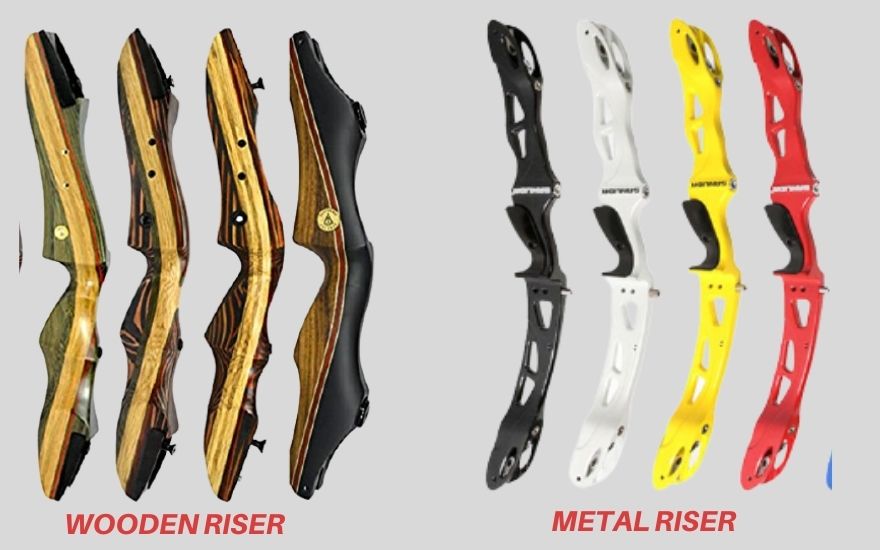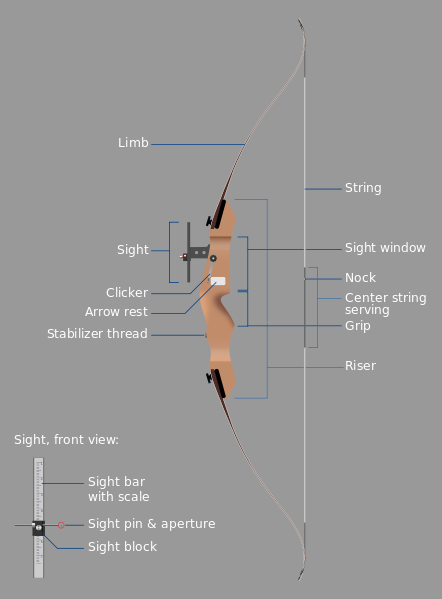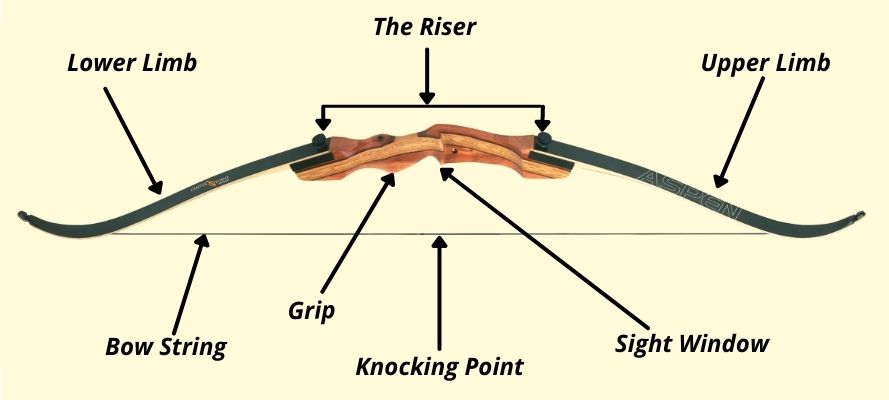A recurve bow is the latest evolution of a traditional bow and consists of several parts. Besides the main parts, a recurve has so many add-ons or attachments made for precision, convenience, and accuracy.
Merely knowing in-depth about the various parts and the accessories will not make you a skilled hunter or archery champion in Olympic Games. But authority knowledge on different parts of a recurve bow and how they work is a must to master the craft of archery.
This article will brief on the crucial parts of a recurve, what they are made of, and what role each part plays. Thus, read on to have an ultimate guide on different parts of a recurve bow.
Table of Contents
7 Recurve Bow Parts Explained
Here you go with the recurve bow parts name waiting to be explained and analyzed in the sections ahead.

The Riser
A riser is one of the central part of recurve bow, where the archer's fingers remain on the bow. There are many types of risers made from different materials that change the weight and feel of the bow. Generally, fiberglass or carbon fiber will produce a lightweight bow that shoots arrows with more force. A bow's riser connects the bow limbs to the handle and is notched and shaped to hold the bowstring.
It provides the platform on which the limbs mount, and it gives the string the needed clearance when drawn. The riser is typically made from solid wood or laminate woods such as basswood or African padauk.
To reach the point home, a recurve bow riser provides the foundation from which the archer shoots the arrow. For a riser to perform properly, it needs to be well built and sturdy.
So, it has to be made out of wood because it requires durability and flexibility, two properties only found in wooden materials. The riser's importance is the last thing to underestimate as it considers the entire design of the bow.

Recurve Bow Limbs
Recurve bow limbs serve the purpose of shooting arrows primarily for hunting. The common materials of recurve bow limbs are either wood or composite materials like fiberglass, wood or plastic laminate. As a reminder, wood is brittle and may break if not properly constructed, while carbon fiber is lightweight and very strong.
A recurve bow limb has three main parts; the riser (bow handle), the grip (grip on one end of the bow limb) and the forearm (grip on the other end of the bow limb). In other words, limbs are the components that make the bow bend back on and form a "recurve" shape.
These limbs have many different uses and functions, but their primary purpose is to store the energy generated during a single draw at full draw. And that energy is released in a single shot. The limbs of a recurve bow makeup one-third of the total bow and hold the string and propel the arrow or other projectile. They, most crucial of the archery recurve bow parts, are attached to the upper part of the riser near its center with a screw pin.
The Bow String
There are many different materials used in bowstrings, but they all serve the same function. The type of material used will depend on personal preference and sport requirements. For example, if you participate in archery, an archery-type fiberglass bowstring would be best. However, a more durable material that can resist weathering is needed for hunting purposes.
Many people also choose bowstrings made of animal parts to provide natural camouflage. In conclusion, it is a cord held under tension by the archer through the fingers. The cord is wrapped over the fingers and then around itself to form a loop between two fingers.
Arrow Shelf
The arrow shelf of a recurve bow is the flat surface on the outer side of the bow and serves as a rest for the arrow. That sits perpendicular to the string when it is fully drawn. The purpose is to provide an area for gripping the bow with your fingers when in use.
Shooting at an archery target with a recurve bow is difficult enough. While drawing back and releasing the arrow, you may go worried or unsure about holding onto the bow. Here, the arrow shelf comes to your rescue.
This part of a recurve bow is a critical component and can be either convex or concave shaped, depending on which type of bow design you are in need of. In addition to providing a resting point for arrows, the arrow shelf also provides support and stability to the bow's frame.
A rectangular shape can rest on either end of the string shaped to fit the arrow shaft and provide a more accurate shot.

Photo Source: wikimedia.org
Tips
The tips of a recurve bow have a similar shape to the tips on an arrow. As a result, the tip of the bow is where most kinetic energy is transferred from the archer to the arrow before release. Because of this design, a recurve bow has more power and distance than a longbow.
The tip of a recurve bow is the most crucial of the recurve bow parts as it provides lots of speed, power and accuracy to your shot. Quite the contrary, a bad tip can reduce all of these things.
The best tips are made from exotic woods like Osage orange, maple, or ebony. They are pretty expensive but worth it for the quality. The other option is to make your tip by gluing on an arrowhead to the end of your bowstring.
String Notch
The string notch of a recurve bow is one of the essential parts of the bow. This part is located on the upper limb or right-hand side, and its function is to hold the string in place. A quality string notch will have a deep groove, with room for string notches from both limbs to better stabilize the arrow during release. Thus it lessens the chance that it will fall out.
A handmade recurve bow consists of a curved wooden limb that gradually, but not abruptly, curves away from the archer before ending in a string notch. The strings are attached to this notch and a set of handles at either end.
In archery, a recurve bow is a type of bow in which the tips of the limbs curve away from the archer when strung. This design makes it easier to pull the string without worrying about bracing against the limb tips. That causes a weakening in kinetic energy lost in propulsion.
Knocking Point
The process of knocking point is the crucial step in the bow building process, because it sets up how the string will release from the arrow when fired. Essentially, knocking point is where the arrow will touch the string when positioned on the bow at rest, and should be just below center.
This position ensures that when fired, your bow does not bounce to one side or another. There are many different factors that go into selecting this point including the way the limbs curve, as well as how far from center you want your grip to be. String placement will also have an effect on this point.
However, it can be determined by either shooting from a rest at 20 yards or shooting arrows from the string at 10 yards. The arrow should be knock-kneed so it flies straight and doesn't wobble in flight. This ensures you have a better chance of hitting your target accurately.
FAQs
What is a clicker on a recurve bow?
A clicker is a small metal object attached to the string of a recurve bow. Its purpose is to create a popping noise when it releases from the bowstring. This sound alerts the archer of the arrow's release, and it helps them know if they have drawn back on the string properly.
What are the attachments to a recurve bow?
The attachments on a recurve bow are the various items that a person uses with a recurve bow. They include the arrow, the release aids, and the arm guards. The string is considered an attachment because it stays attached completely to the bow.
Recurve bows and their attachments can be used to hunt for games or as a recreational sport. But attachments or add-ons do not belong to the main parts of a recurve bow.
Do you need a release for a recurve bow?
Recurve bows are one of the more popular types of bows and they come in a variety of shapes and sizes. Some recurve bows come with a piece that must be pulled back before the arrow is shot; this is called a release.
If you're planning on hunting or target shooting with your bow, then it may be worth the investment to purchase the right kind of release for your recurve bow.
Wrap Up
A recurve bow is the type of bow that uses a spring to pull the string back. The string is attached to a small arm, a limb, which has a point. The other end of the string stays attached to the bow's body or the place where the arrow sits.
At the end of the string is a broadhead, which is the sharp tip of the arrow. The broadhead is usually made of metal, but many different types come in different materials.
You have reached thus far is evident that you are now fully aware of all the parts of a recurve bow and how they contribute to the bowing mechanism. This knowledge will help you maneuver the bow to make the best out it.
Read Related Beginner Guides:

